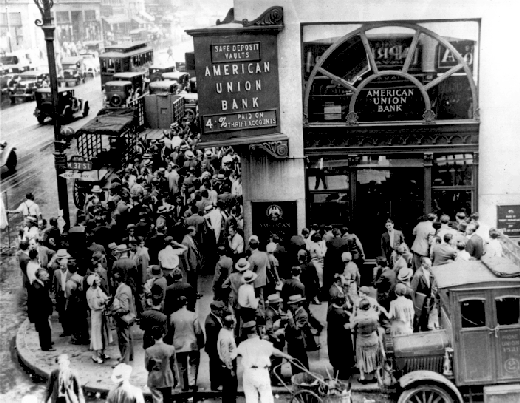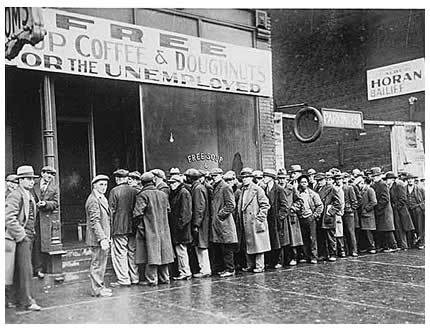The Great Depression of 1929 Causes and How It Ended
Post on: 19 Август, 2015 No Comment

What Was The Great Depression of 1929?
The Great Depression of 1929 was a worldwide depression that lasted for 10 years. Its kickoff in the U.S. economy was “Black Thursday , October 24, 1929, when 12.9 million shares of stock were sold in one day, triple the normal amount. Over the next four days, prices fell 23%. This was known as the stock market crash of 1929 .
Unemployment Reached 25% During the Great Depression
By 1933, the height of the Depression, unemployment had risen from 3% to 25% of the nation’s workforce. Wages for those who still had jobs fell 42%. GDP was cut in half, from $103 to $55 billion. This was partly because of deflation. where prices fell 10% per year. Panicked government leaders passed the Smoot-Hawley tariffs to protect domestic industries and jobs. As a result, world trade plummeted 65% as measured in dollars and 25% in total number of units.
Life During The Great Depression
The Depression caused many farmers to lose their farms. At the same time, years of erosion and a drought created the “Dust Bowl ” in the Midwest, where no crops could grow. Thousands of these farmers and other unemployed workers traveled to California to find work. Many ended up living as homeless “hobos” or in shantytowns called “Hoovervilles , named after then-President Herbert Hoover.
What Caused the Great Depression of 1929?
According to Ben Bernanke. the current Chairman of the Federal Reserve. the stock market crash and the subsequent Depression were actually caused by tight monetary policies that the Federal Reserve instituted at that time.
Bernanke highlighted several key Fed mistakes:
- The Fed began raising the Fed Funds rate in the spring of 1928, and kept raising it through a recession that began in August 1929. This led to the stock market crash in October 1929 .
- When the stock market crashed, investors turned to the currency markets. At that time, dollars were backed by gold held by the U.S. Government. Speculators began selling dollars for gold in September 1931, which caused a run on the dollar.
- The Fed raised interest rates again to preserve the value of the dollar. This further restricted the availability of money for businesses, causing more bankruptcies.
- The Fed did not increase the supply of money to combat deflation.
- As investors withdrew all their dollars from banks. the banks failed, causing more panic. The Fed ignored the banks’ plight, thus destroying any remaining consumers’ confidence in banks. Most people withdrew their cash and put it under the mattress, which further decreased the money supply .

Bottom line. thanks to the Fed, there was just not enough money in circulation to get the economy going again. Instead of pumping money into the economy, and increasing the money supply, the Fed allowed the money supply to fall 30%.
What Ended the Great Depression of 1929?
In 1932, Franklin D. Roosevelt was elected President based on his promises to create Federal Government programs to end the Great Depression. Within 100 days the New Deal was signed into law. This created 42 new agencies designed to create jobs, allow unionization, and provide unemployment insurance. Many of these programs, such as Social Security. the SEC (Securities and Exchange Commission), and FDIC (Federal Deposit Insurance Corporation) are still here today, helping to safeguard the economy. ( Source: Roosevelt Institute, The New Deal )
Many argue that New Deal didn’t end the Depression, that World War II did. However, if FDR had spent as much on the New Deal as he did on the War, it would have ended the Depression. From 1932, when the New Deal was launched, to 1941, when Japan attacked Pearl Harbor. spending only increased the debt by $3 billion. In 1942, defense spending added $23 billion to the debt. and $64 billion in 1943. If that much had been spent on the New Deal, it would have been enough to end the Depression.
In fact, WWII had its roots in the Depression,which allowed a desperate people to elect Hitler as Chancellor in 1933. If FDR had spent enough on the New Deal to end the Depression before Hitler consolidated his power, World War II may never have happened.
Could a Great Depression Happen Again?
A Depression on the scale of that in 1929 could not happen exactly the way it did before. Central banks around the world, including the U.S. Federal Reserve, are so much more aware of the importance of monetary policy in regulating the economy.
However, there is only so much monetary policy can do to offset fiscal policy. The incredible size of the U.S. current account deficit, and the national debt. could possibly trigger an economic panic that would be difficult for monetary policy to affect. No one really knows, since the current U.S. debt level is unprecedented.
The current thinking is that a Great Depression could not happen again because the global economy is much more integrated, and all central banks are working together to make sure it doesn’t. (Source: The Federal Reserve Board web site, “Remarks by Governor Ben Bernanke at the H. Parket Willis Lecture in Economic Policy ”, March 2, 2004, FDR Library Web Site.) Article updated January 7, 2015














